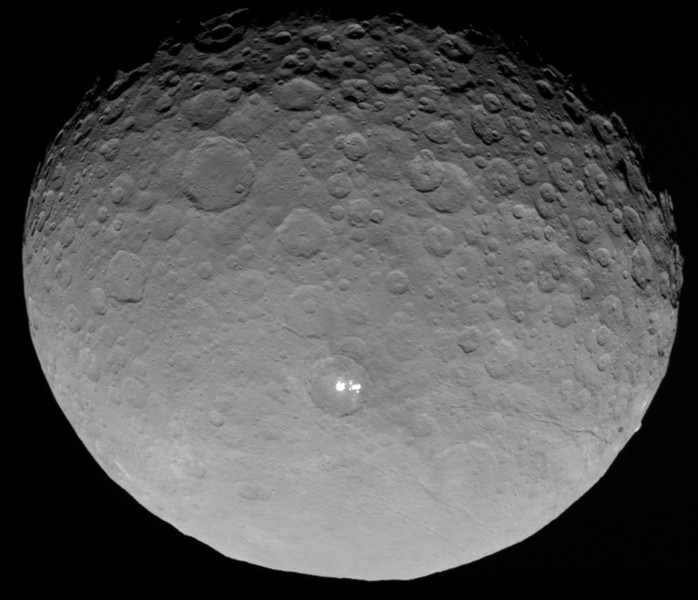Dwarf planet Ceres: Mysterious bright spots could be ice or salt, speculate scientists

Bright spots on the dwarf planet Ceres continue to tantalise astronomers with speculations on their origin suggesting that the light reflected could be from impure ice or salty crusts left behind by vapourised water.
The latest sequence of images was taken by Nasa's Dawn spacecraft on 3-4 May.
The images, taken at a distance of 13,500kms by Dawn in its first mapping orbit after a complete 15-day full circle around Ceres, have a resolution of 1.3kms per pixel.
The brightest spots within a crater in the northern hemisphere seem to be composed of many smaller spots. However, their exact nature remains unknown and is subjected to numerous speculations.
More will be known in the next phase when Dawn will circle Ceres about every three days at an altitude of 4,400 kilometers -- three times closer than previously.
"Dawn scientists can now conclude that the intense brightness of these spots is due to the reflection of sunlight by highly reflective material on the surface, possibly ice," said Christopher Russell, principal investigator for the Dawn mission from the University of California, Los Angeles.
However, it is expected that ice should be unstable on the dwarf planet's airless surface, turning from a solid into a gas and drifting into space rather than sticking around. This could mean the white patches are impure ice.
Mark Sykes, director of the Planetary Science Institute and a Dawn co-investigator speculates that the largest spot dubbed the "Great White Spots", might mostly be salty crusts left behind after mineral-rich water ice vapourises.
There are many such spots dotting the dwarf planet's surface with each group significantly different in size and brightness.
Mike Brown, an astronomer and planetary scientist at the California Institute of Technology who is not part of the Dawn team told Scientific American, "My best guess is that there is a layer of ice not very far below the visible surface and that impacts punch through it. What would be more interesting is if there is a layer of liquid not too far down and you punch through and allow venting."
On 9 May, Dawn powered on its engine and began the month-long descent toward its second mapping orbit, which it will enter on 6 June.
Dawn is the first mission to visit a dwarf planet, and the first to orbit two distinct solar system targets. It studied giant asteroid Vesta for 14 months in 2011 and 2012, and arrived at Ceres on 6 March 2015.
The animation of the image sequence can be see here.
Ceres is 950kms in diameter and was discovered in 1801. It is the largest object in the asteroid belt between Mars and Jupiter.
Ceres is quite similar to Jupiter's moon Europa and Saturn's moon Enceladus, with potentials for harbouring life.
The abundance of water in bodies like Ceres suggests that as giant planets migrated they disturbed the small rocky and icy asteroids and comets, causing them to hit early Earth and deliver organic molecules and water in the process.
© Copyright IBTimes 2025. All rights reserved.





















